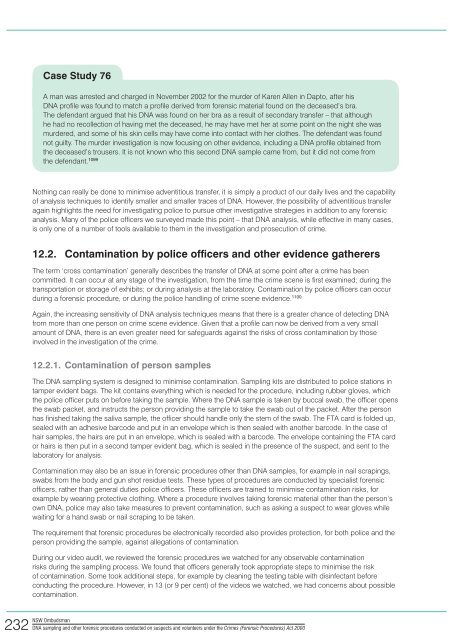Crimes (Forensic Procedures) Act 2000 - NSW Ombudsman - NSW ...
Crimes (Forensic Procedures) Act 2000 - NSW Ombudsman - NSW ...
Crimes (Forensic Procedures) Act 2000 - NSW Ombudsman - NSW ...
Create successful ePaper yourself
Turn your PDF publications into a flip-book with our unique Google optimized e-Paper software.
Case Study 76<br />
A man was arrested and charged in November 2002 for the murder of Karen Allen in Dapto, after his<br />
DNA profile was found to match a profile derived from forensic material found on the deceased’s bra.<br />
The defendant argued that his DNA was found on her bra as a result of secondary transfer – that although<br />
he had no recollection of having met the deceased, he may have met her at some point on the night she was<br />
murdered, and some of his skin cells may have come into contact with her clothes. The defendant was found<br />
not guilty. The murder investigation is now focusing on other evidence, including a DNA profile obtained from<br />
the deceased’s trousers. It is not known who this second DNA sample came from, but it did not come from<br />
the defendant. 1099<br />
Nothing can really be done to minimise adventitious transfer, it is simply a product of our daily lives and the capability<br />
of analysis techniques to identify smaller and smaller traces of DNA. However, the possibility of adventitious transfer<br />
again highlights the need for investigating police to pursue other investigative strategies in addition to any forensic<br />
analysis. Many of the police officers we surveyed made this point – that DNA analysis, while effective in many cases,<br />
is only one of a number of tools available to them in the investigation and prosecution of crime.<br />
12.2. Contamination by police officers and other evidence gatherers<br />
The term ‘cross contamination’ generally describes the transfer of DNA at some point after a crime has been<br />
committed. It can occur at any stage of the investigation, from the time the crime scene is first examined; during the<br />
transportation or storage of exhibits; or during analysis at the laboratory. Contamination by police officers can occur<br />
during a forensic procedure, or during the police handling of crime scene evidence. 1100<br />
Again, the increasing sensitivity of DNA analysis techniques means that there is a greater chance of detecting DNA<br />
from more than one person on crime scene evidence. Given that a profile can now be derived from a very small<br />
amount of DNA, there is an even greater need for safeguards against the risks of cross contamination by those<br />
involved in the investigation of the crime.<br />
12.2.1. Contamination of person samples<br />
The DNA sampling system is designed to minimise contamination. Sampling kits are distributed to police stations in<br />
tamper evident bags. The kit contains everything which is needed for the procedure, including rubber gloves, which<br />
the police officer puts on before taking the sample. Where the DNA sample is taken by buccal swab, the officer opens<br />
the swab packet, and instructs the person providing the sample to take the swab out of the packet. After the person<br />
has finished taking the saliva sample, the officer should handle only the stem of the swab. The FTA card is folded up,<br />
sealed with an adhesive barcode and put in an envelope which is then sealed with another barcode. In the case of<br />
hair samples, the hairs are put in an envelope, which is sealed with a barcode. The envelope containing the FTA card<br />
or hairs is then put in a second tamper evident bag, which is sealed in the presence of the suspect, and sent to the<br />
laboratory for analysis.<br />
Contamination may also be an issue in forensic procedures other than DNA samples, for example in nail scrapings,<br />
swabs from the body and gun shot residue tests. These types of procedures are conducted by specialist forensic<br />
officers, rather than general duties police officers. These officers are trained to minimise contamination risks, for<br />
example by wearing protective clothing. Where a procedure involves taking forensic material other than the person’s<br />
own DNA, police may also take measures to prevent contamination, such as asking a suspect to wear gloves while<br />
waiting for a hand swab or nail scraping to be taken.<br />
The requirement that forensic procedures be electronically recorded also provides protection, for both police and the<br />
person providing the sample, against allegations of contamination.<br />
During our video audit, we reviewed the forensic procedures we watched for any observable contamination<br />
risks during the sampling process. We found that officers generally took appropriate steps to minimise the risk<br />
of contamination. Some took additional steps, for example by cleaning the testing table with disinfectant before<br />
conducting the procedure. However, in 13 (or 9 per cent) of the videos we watched, we had concerns about possible<br />
contamination.<br />
232<br />
<strong>NSW</strong> <strong>Ombudsman</strong><br />
DNA sampling and other forensic procedures conducted on suspects and volunteers under the <strong>Crimes</strong> (<strong>Forensic</strong> <strong>Procedures</strong>) <strong>Act</strong> <strong>2000</strong>

















